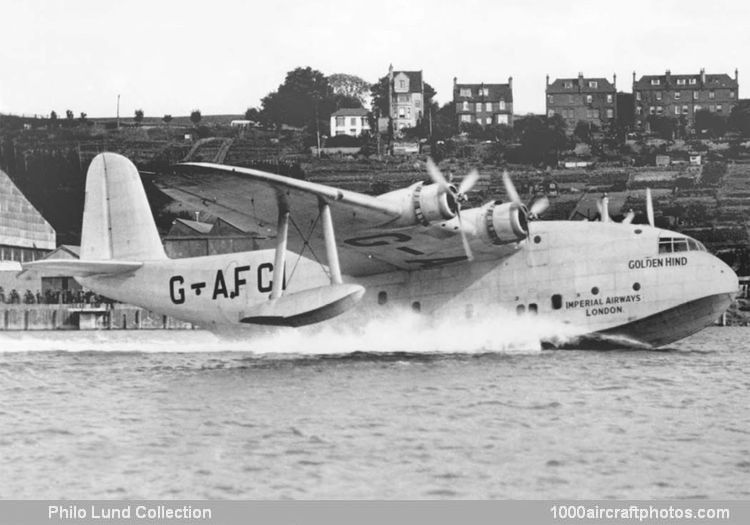08/31/2014. Remarks by Johan Visschedijk: "Following the complete success of the S.23 flying boat (better known as the Empire Flying Boat, but also referred to as 'C' Class Flying Boat), Imperial Airways in late 1937 discussed with the Air Ministry the possibility of using the powerful new Bristol Hercules fourteen-cylinder sleeve-valve engine in aircraft with transatlantic range. Three S.26 flying boats were ordered and the first, registered G-AFCI, was flown by Short's Chief Test Pilot John Lankester Parker on July 21. Named Golden Hind it was the first of the so-called G class (hence the type was also referred to as 'G' Class Flying Boat), the other two becoming Golden Fleece (G-AFCJ c/n S.872) and Golden Horn (G-AFCK c/n 873).
Though strikingly similar to the S.23 and relatives, the S.26 was a much larger and heavier boat and had more than double the range/payload capability. Among the more important changes was the four-man flight-deck of the Sunderland and the latter's tall vertical rear step and higher stern.
These fine boats had not entered revenue service when WW II broke out. Though they would have been valuable civil transports the need for long-range Atlantic patrol aircraft was pressing. They were impressed into the RAF in 1940, with their crews, and given serial numbers X8273 to X8275. Major rebuild followed in the course of which they were equipped with Boulton Paul four-gun turrets at the tail and two dorsal positions, a large Sunderland-type weapon bay under the wing in the hull and a complex ASV.II radar installation.
The three aircraft were based at Mount Batten (near Plymouth, Devon), on attachment to No. 10 Squadron, RAAF, for special flights to Gibraltar and the Middle East, mainly with ammunition and spares for RAF No. 272 Squadron's Beaufighters based on Malta and Egypt. These long-range operations began on June 11, 1941, but on the 20th X8274 Golden Fleece, outward bound for Gibraltar, developed trouble in two engines simultaneously and made a forced alighting in heavy swell off Cape Finisterre, Spain; the hull caved in, and eight of the crew and one passenger were drowned, the only other passenger and remaining four crew being rescued and taken prisoners by a German U-boat called to the scene by an enemy seaplane.
At the end of 1941 the two survivors, Golden Hind and Golden Horn, were re-civilianized (though their tailcones had been lost, so the rear turret was simply faired over). They began the long Poole (UK) Lisbon (Portugal) Bathurst (presently Banjul, Gambia) Accra (Ghana) Freetown (Nigeria) Lagos (Nigeria) service, Lisbon-Bathurst alone being a thirteen-hour sector. On the northbound run from Lisbon refugees and RAF escapees were aboard on every trip, but on January 9, 1943, Golden Horn (G-AFCK c/n 873) caught fire in the air on an air-test and crashed into the Tagus losing twelve lives.
Golden Hind, the only surviving S.26, was completely rebuilt in 1944 and as a 38-seater with crew of seven operated the route Durban (South Africa) Lourenηo Marques (presently Maputo, Mozambique) Beira (Mozambique) Mombasa (Kenya) and also the route Kisumu (at Victoria Lake, Kenya) Mombasa (Kenya) Pamanzi (French Territory) Madagascar Seychelles, soon extended via the Maldives to Ceylon (India). In late 1945 it was rebuilt again by Short & Harland at Belfast as a luxurious 24-seater with Hercules XIVs and flew Poole (UK) Augusta (Italy) Cairo (Egypt) until September 21, 1947. G-AFCI was sunk in a gale at Harty Ferry, England, in May 1954."
